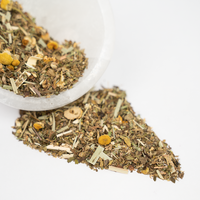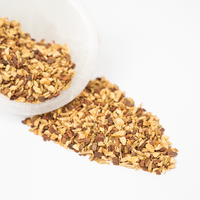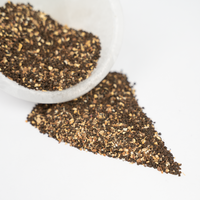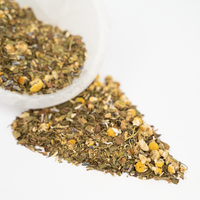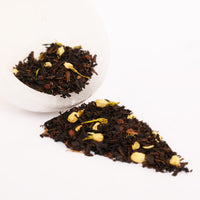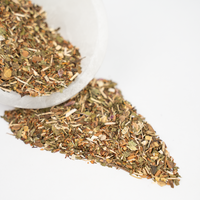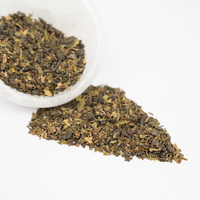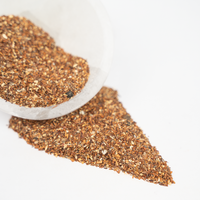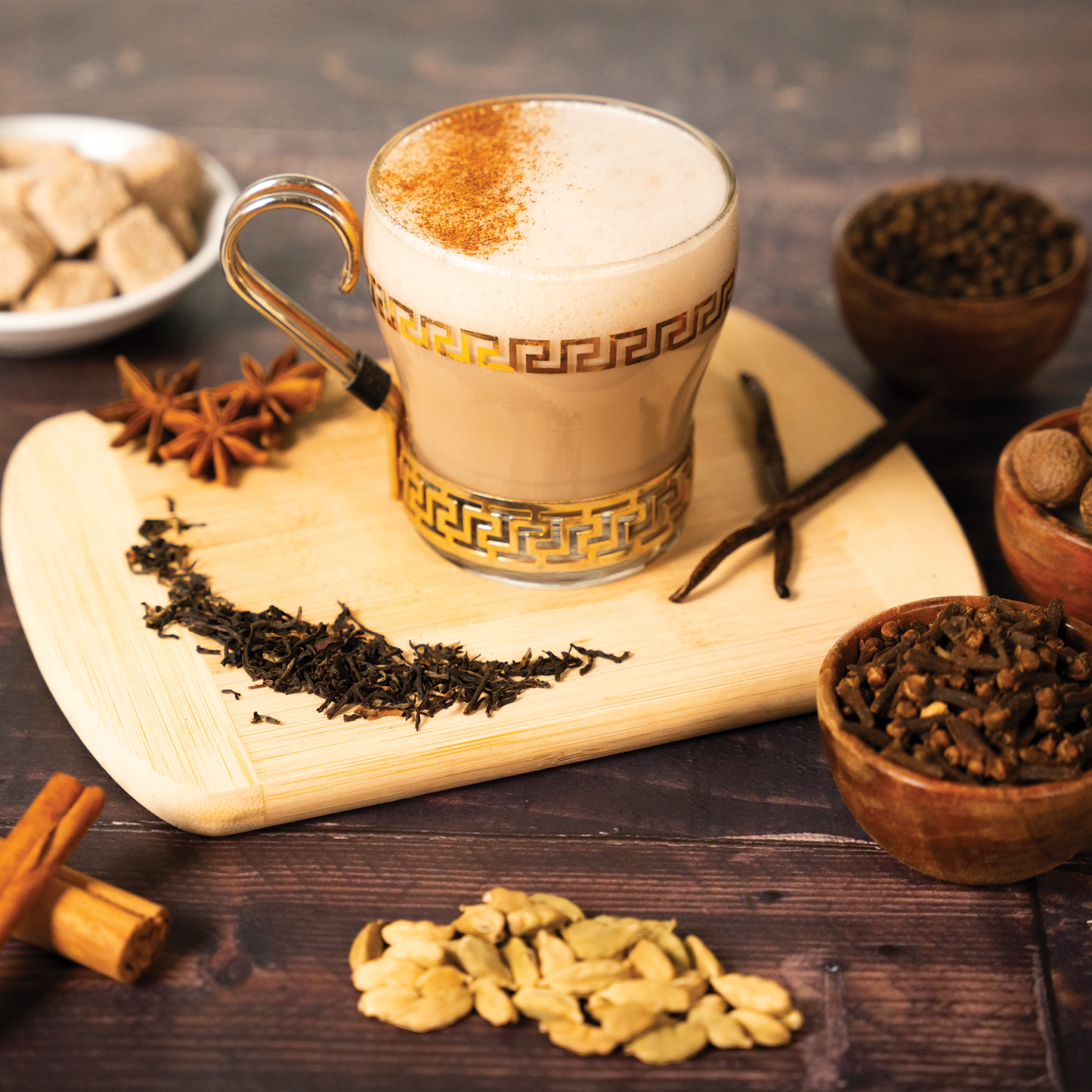Save 20% On our feature teas all month long!
Learn Tea
To learn about the differences between loose leaf tea and teabags, check out our podcast on Steeping Around:
Hanging Loose: Teabags vs. Loose Leaf Tea
The Perfect Cup
The first thing to consider when preparing tea is water. Water makes up 99% of any cup of tea. Exceptional tea can’t compensate for poor quality water while superb water will produce a good cup of even the lowest of teas. Chlorinated, distilled, or pure water is not favorable for brewing tea. Ideally, water should have an attractive combination of total dissolved solids and minerals (calcium, sodium, magnesium, iron and others) which provide flavor and reactivity. NOTHING is more important than water for brewing great tea.
Once you have quality water, brewing great tea is actually quite simple. There are only three things to manage: tea amount, steep time, and water temperature. When these three factors are properly managed, a superb brew is almost guaranteed. Below is a basic chart identifying some measures for water temperature and steep times for different types of tea:
|
Tea Type
|
Water Temp.
|
Steep Time
|
Infusions
|
|
White Tea
|
170 F – 180 F
|
1-2 minutes
|
2-3
|
|
Green Tea
|
170 F – 180 F
|
1-2 minutes
|
3-4
|
|
Oolong Tea
|
190 F – 200 F
|
2-3 minutes
|
3-4
|
|
Black Tea
|
195 F – 210 F
|
3-4 minutes
|
1-2
|
|
Herbal Tea
|
200 F – 210 F
|
2-3 minutes
|
1-2
|
The reality is that these are general guidelines and that of the three factors that need to be managed, you only need to be good at one – measuring the appropriate amount of dry leaves. Typically 1 -1 ½ teaspoons of loose leaf tea per cup is a good starting point. All of our teas have general preparation guidelines enclosed. Ultimately, you are in control with loose leaf tea and can make it as you like.
That said, if you prefer deep bitter flavor, try steeping you tea for longer or opting for a larger serving time. If you prefer something subtle, try using more water of less teas. For the perfect balance, oversteep your tea and then add water or ice to cool off the cup without losing flavor.
In order to brew loose leaf tea, you will need a device to either steep or strain the tea. Disposable tea filters are one option, but a tea strainer or a teapot with a built-in infuser is better. Tea balls, cloth filters, and spoon infusers typically are not a great option as the tea is not given appropriate space to infuse. Check out our selection of infusers and filters here.
To learn more about brewing a perfect cup of loose leaf tea, check out our podcasts on Steeping Around:
How to Make a Great Cup of Tea
How to Make a Great Cup of Tea-Part 2
Time to Chill
There are several considerations to keep in mind when making iced tea, no matter the method you choose. First, make sure you use good quality filtered water. Your ice cubes should be of the same quality as the water itself, as they will melt and impart their flavors on your finished drink. Second, moderate the amount of ice you use in your glass. Using too much ice can have a numbing effect on taste buds. Third, store your iced tea in a glass container, rather than plastic or metal. Finally, if you are making a large amount, only keep your iced tea for two to three days for optimal flavor and clarity.
Hot-Brew Methods
One Glass at a Time. Begin by heating your water to the appropriate temperature for the type of tea that you intend to use. For variations on water temperature and steep times, refer to our chart above. Once the water has reached its optimal temperature, add your tea leaves. This is where the recipe differs from the hot tea instructions: you will use twice the amount of tea leaves that you would typically use for a cup of hot tea. Generally, this is about two to three teaspoons per eight ounces of water. Allow these leaves to infuse with the hot water for the same amount of time that you would use for hot tea; meanwhile, grab a tall glass and fill it completely with ice. It is important to brim your glass with ice—once your tea has steeped, you will strain it slowly over the ice, melting it little by little and diluting your tea to the proper concentration.
Large-Batch. If you’re preparing a large batch of iced tea for storage in your refrigerator and continued enjoyment, you will use the same techniques that you would employ in making a pot of hot tea over the stovetop. In general, use about two and a half grams of tea for every six ounces of water. For more specific variations on water temperatures and steep times, refer to our chart on the Hot Tea Preparation page. Be sure to allow your tea to cool to room temperature before transferring it to your refrigerator, and only make enough tea to last for two to three days.
The Mr. Coffee Method. This is an easy, everyday way to make iced tea in a large batch. Simply add your loose-leaf tea to a filter, place in your coffeepot, and brew as you would your morning coffee. Once the brew cycle is complete, pour your tea into a storage container and place in the refrigerator for cooling. There are two potential problems with this method however: first, tea needs to remain in contact with hot water for a longer time than coffee grounds. To lengthen the leaf exposure to water, simply use an additional filter or two for your brew—this will slow the water flow to its proper speed. The second notable issue is in flavor-mixing: if your coffee pot is used as it is intended, for coffee, it will likely impart some of those roasty flavors into your tea. The only sure way to avoid this is to invest in a second brew cone for your pot. One would be used strictly for tea, and the other for coffee. If you are able to tend to these issues, brewing in your coffeepot could be the perfect alternative for you.
If you want to take your ice tea skills to the next level, check out our iced tea guide.
To learn more about hot-brew methods, check out our podcast on Steeping Around:
Talking Iced Tea–Part 2: Hot Brewing
Colors of the Rainbow
Black tea
Black tea is the most consumed tea in the world and is grown in several countries around the globe. It is available in many varieties, which vary in color from light amber to deep red, and the flavor can range from light, fruity and refreshing to strong and malty. Because it is cultivated all over the world and in a variety of environments it has a wide range of quality, but it is not only the region that affects the tea. As with all teas, the season of harvest, leaf size, and method of production all affect the final product.After the tea is harvested, the leaves are allowed to wither for up to twenty-four hours before they are rolled. They are then rolled, twisted and broken up, releasing naturally occurring enzymes. This can be done one of two ways: by hand, called “orthodox”, or by mechanical means, which is called “CTC” (cut, tear, curl). The former method results in larger, fuller leaves, whereas the latter will produce a much stronger cup.
Next, the leaves are placed in a cool, humid area to oxidize. The amount of time the tea oxidizes is dependent on the type of tea that is being produced. As a general rule, black teas are left in this state for longer than any other type of tea. When the leaves have reached the desired level of oxidation, they are fired in ovens where the oxidation is stopped and the flavor is sealed in. It is during this stage that the leaves gain their traditional dark, blackened hue.
Check out our selection of black teas.
To learn more about black tea, check out our podcasts on Steeping Around:
I'll Take My Black Tea With...
Black Tea: A Lesson in Strength
Storytime: The Sorted Beginnings of Black Tea
Green Tea
Green tea originated in China and is known as the first type of tea ever produced. It continues to be grown in every tea-producing province of China and in Japan. Each country and region has its own special method for harvesting and processing green tea, and as a result each variety has a unique flavor. In general, green tea offers a smooth, vegetal flavor.
During harvesting, only the buds and tips at the top of the plant are plucked. After harvesting, the leaves are quickly dried and then lightly heated, which brings the oxidation process to a quick halt. The method of heating varies; in China, the leaves are pan-fried in a wok or a heated drum, but in Japan they are usually steamed. The next step in the process is rolling, and as with black tea it can be accomplished by either hand or by machine. The method of rolling determines the size and shape of the leaf—green tea leaves may be twisted, flat, or ball-shaped, and each style of rolling will alter the resulting flavor of the tea.
Check out our selection of green teas.
To learn more about green tea, check out our podcasts on Steeping Around:
Grateful for Green: The Colorful History of Green Tea
The Many Benefits of Drinking Green Tea
Judging Green Tea–From Harsh to Hip
White Tea
White tea is traditionally grown only in the high mountains of the northern part of the Fujian Province of China and is quite rare. Many tea experts consider it to be one of the finest teas in the world. It is the least processed of all teas, and recent studies have shown white teas to contain less caffeine and a higher concentration of antioxidants than any other type of tea.
White tea is harvested briefly each spring from a specific type of tea plant. The smallest and youngest buds of the tea plant are covered in fine white hairs. These young buds are plucked and delicately processed. Authentic white tea is lightly steamed immediately after being picked, before the leaves begin to wilt and before too much oxidation can take place. The result is a delicate, pure tea with a fair color and gentle taste.
Check out our selection of white teas.
To learn more about white tea, check out our podcasts on Steeping Around:
The Story of White Tea: Origins & Explanations
Herbal Tea
Many other plants that do not have their origins in either Camellia sinensis or assamica may be infused in hot water and enjoyed. Though they do not come from the tea plant, we call these infusions “tea” in reference to the cup of steaming liquid. More appropriately, these are herbal tisanes. An herbal tea or tisane is an herbal infusion that is made by pouring boiling water over fresh or dried flowers, leaves, seeds or roots, steeping and then straining. This is done with plants from all over the world, each boasting a unique color, flavor, and effect on the body. Many of the health benefits attributed to herbal teas have been passed down for generations, for example the calming effect of chamomile flowers. Others have been more recently researched and documented. Each of our herbal blends features a unique combination of herbs, and will contribute to your overall health in a specified way—please refer to each tea for its specific profile and characteristics.
Check out our selection of herbal teas.
To learn more about herbal tea, check out our podcast on Steeping Around:
To learn more about the benefits of drinking tea for your health, check out our podcasts on Steeping Around:
The Historic History of Tea and Health
EGCG and German Shepherds: Man’s Best Friends
Theo-what? A Medical Perspective on Xanthines in Tea
Teeth and Tea: Old-Time Remedies
Tea and the Big Four: Weight Loss, Cholesterol, Diabetes, and Cancer
Oolong Tea
Oolong tea is described as being neither green nor black, but somewhere in the middle. This is due to the complex nature of oolongs, which offer more variation in regards to color, shape, and flavor than any other type of tea. Some oolongs are delicate and grassy, whereas others are thick and robust. Oolong teas can differ in tea plant variety, growing region, and the method of processing, but most importantly in their degree of oxidation. Oxidation is the most important factor of the final color and flavor of the tea.When harvesting oolongs, three to four leaves and a bud are usually picked and allowed to wither. After the leaves have wilted they are shaken in baskets until bruised and torn. The leaf is then exposed to air, where oxidation occurs. This is the point at which the one oolong begins to differ greatly from another. Oolongs can have anywhere from 10% to 70% oxidation, and depending on the level of oxidization permitted, an oolong can resemble either a light green tea or a rich black tea. After the desired amount of oxidation, the leaves are gently heated to stop the process.
Check out our selection of oolong teas.
To learn more about oolong tea, check out our podcasts on Steeping Around:
Crazy About Oolongs: A Few of My Favorite Things
The Two “O”s: Oolongs and Oxidation
Chai
Chai refers to a style of preparation, rather than a classification of tea. It has been consumed in India for centuries, but this rich tea has been steadily gaining popularity in the western hemisphere. Today, the “chai latté” is an essential item on any coffeehouse menu, and is a favorite among tea and coffee drinkers alike.
Chai is comprised of black tea and a unique combination of spices, called masala, and is typically served with milk and sugar. In India, the taste of chai can vary greatly based on the quality of the tea and the choice of masala. The recipe differs from home to home, but in general chai masala consists of a blend of ginger, cloves, cardamom, cinnamon, vanilla, saffron, coriander, black pepper, and anise.
Check out our chai blends and concentrates.
To learn more about chai tea, check out our podcasts on Steeping Around:
My Chai: From the Kitchen to the Air
Pu'er
Pu'er is a dark, fermented black tea with a unique, earthy taste. Originating very early in Chinese tea history and the process by which it is manufactured has always been a closely guarded secret. After the leaves are harvested they are completely fermented, perhaps twice. The tea is usually then compressed into brick and disc-like shapes, but can be left loose. Once it has been processed, Pu'er is stored for an indiscriminate amount of time—anywhere from a couple of months to over a century. It is usually within ceramic pots, which impart their flavor to the enclosed leaves.
Much like wine, Pu'er is the only type of tea that improves in quality and increases in value with age. Not only is Pu'er immune to age, but to ill-preparation—there is little that one can do during the brewing process to negatively affect the flavor. Whereas most teas will grow bitter when they have been steeped for more than a few minutes or with too hot of water, Pu'er can be brewed with boiling water and there is virtually no amount of time that will make it sour. The color of the brewed tea is dark red or brown, the flavor rich and earthen.
To learn more about pu'er tea, check out our podcasts on Steeping Around:
Fermentation, Fungus, and Fabulous Puer Tea
Talk Over Tea–The History and Health Benefits of Puer
History
For 5000 years, tea has been a key aspect of many culture. From foreign affairs to health and medicine, tea has found it's place in many parts of life. Since its discovery by humans, tea has been at the center of multiple controversies, tragedies, and remarkable events.
Tea has a long and complex history. Enlightenment, art, war, oppression, and revolution are just a few aspects of human history that are closely linked with the most popular drink on earth.
To learn more about the history of tea, check out our podcasts on Steeping Around:
The Beginning – What is tea, anyway?
Caffeine
While tea is often used to perk up a busy morning, it can also be a calming way to end a busy day. Nothing is worse than finding out all too late that your favorite blend is great in the morning, but a bad choice in the evening. But you can spare yourself sleepless nights and groggy mornings by knowing the caffeine content of your favorite teas.
Generally speaking the caffeine content of a cup of tea will vary by the type of tea, how long you brew and how much tea you use in each serving. When brewed longer or with more leaves per cup, you'll get a stronger tea both in flavor and in caffeine content. With this in mind, we've put together a general guideline for a typical 8oz cup.
Caffeine Guidelines:
|
Tea Type |
Caffeine Content |
|
Herbal Teas * |
0mg |
|
Decaf Black Teas |
5mg |
|
Green Teas |
25-30mg |
|
White Teas |
25-30mg |
|
Oolong Teas |
25-40mg |
|
Black Teas |
45-50mg |
|
Yerba Mate & Guayusa Teas |
65-80mg |
At Maya Tea we like to offer a wide variety of products to meet our customers needs. Although we have many caffeinated options, we also many delicious caffeinated choices as well. Check them out here!
* Herbal Teas here refers to blends such as Chamomile, Hibiscus, Honeybush, Rooibos and other naturally caffeine-free teas. Exceptions to this would be Yerba Mate, Guayusa and other "high octane" herbals teas.
